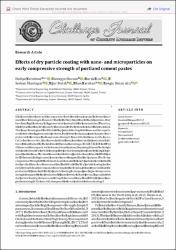Effects of dry particle coating with nano- and microparticles on early compressive strength of portland cement pastes

View/
Access
info:eu-repo/semantics/openAccessDate
2021Author
Yorulmaz, HediyeUzal, Burak
Özuzun, Sümeyye
İlkentapar, Serhan
Durak, Uğur
Karahan, Okan
Atiş, Cengiz Duran
Metadata
Show full item recordAbstract
It is known that nano-and microparticles have been very popular in recent years since their advantages. However, due to the very small size of such materials, they have very high tendency to agglomeration particularly for nanoparticles. Therefore, it is critical that they are properly distributed in the system to which they are added. This paper investigated the effects of dry particle coating with nano-and microparticles to solve the agglomeration problem. For a clear evaluation, paste samples were preferred to detemine the compressive strength. Nano-SiO2 and nano-CaCO3, micro-CaCO3 and micro-SiO2, also known as silica fume, were selected as particulate additives. It was studied by the addition of various percentages (0.3, 0.7, 1, 2, 3 and 5%) of nano-and microparticles in cementitious systems, replacing cement by weight with and without dry particle coating. Dry particle coating was made by using a high-speed paddle mixer. Portland cement and additive particles were mixed at 1500 rpm for 30 seconds in high-speed powder mixer designed for this purpose. The 3-day compressive strength of the cement-based samples to which particles were added at the specified rates was determined and the effect of the dry particle coating on the early strength was investigated. According to the results, it was observed that the production of paste with the dry particle coating technique gave higher compressive strength compared to the production of paste directly in early period. Especially with dry particle coating, compressive strength increased more than 100% in paste samples containing 0.3% nano-SiO2 compared to direct addition without coating.

















